For the 2025 school year, there are 2 public elementary schools serving 742 students in Ogdensburg City School District. This district's average elementary testing ranking is 3/10, which is in the bottom 50% of public elementary schools in New York.
Public Elementary Schools in Ogdensburg City School District have an average math proficiency score of 28% (versus the New York public elementary school average of 41%), and reading proficiency score of 41% (versus the 48% statewide average).
Minority enrollment is 4% of the student body (majority Black and Hispanic), which is less than the New York public elementary school average of 61% (majority Hispanic).
Overview
This School District
This State (NY)
# Schools
3 Schools
3,702 Schools
# Students
1,417 Students
1,750,092 Students
# Teachers
139 Teachers
153,310 Teachers
Student : Teacher Ratio
10:1
10:1
District Rank
Ogdensburg City School District, which is ranked #605 of all 1,015 school districts in New York (based off of combined math and reading proficiency testing data) for the 2021-2022 school year.
The school district's graduation rate of 75-79% has increased from 70-74% over five school years.
Overall District Rank
#584 out of 1020 school districts
(Bottom 50%)
(Bottom 50%)
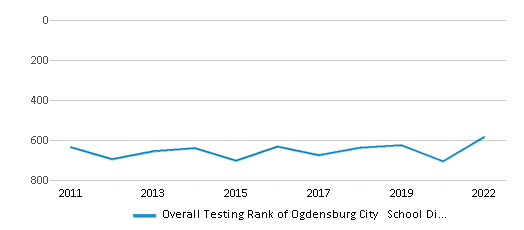
Math Test Scores (% Proficient)
37%
46%
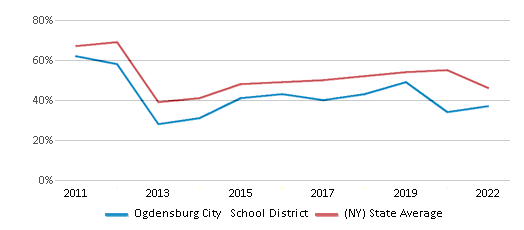
Reading/Language Arts Test Scores (% Proficient)
48%
49%
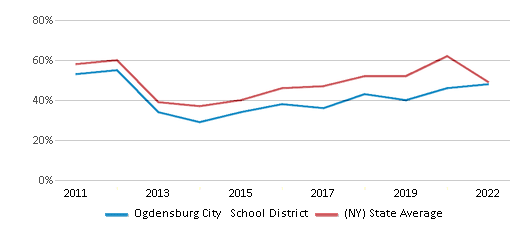
Science Test Scores (% Proficient)
85%
78%
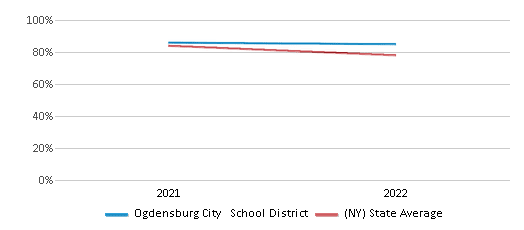
Graduation Rate
75-79%
87%
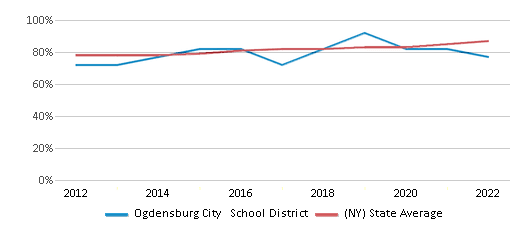
Students by Ethnicity:
Diversity Score
0.05
0.73
# American Indian Students
n/a
14,013 Students
% American Indian Students
n/a
1%
# Asian Students
3 Students
175,821 Students
% Asian Students
n/a
10%
# Hispanic Students
7 Students
531,348 Students
% Hispanic Students
1%
30%
# Black Students
6 Students
278,768 Students
% Black Students
n/a
16%
# White Students
1,378 Students
682,836 Students
% White Students
97%
39%
# Hawaiian Students
n/a
3,810 Students
% Hawaiian Students
n/a
n/a
# Two or more races Students
23 Students
63,556 Students
% of Two or more races Students
2%
4%
Students by Grade:
# Students in PK Grade:
68
60,112
# Students in K Grade:
122
169,096
# Students in 1st Grade:
94
177,074
# Students in 2nd Grade:
84
181,096
# Students in 3rd Grade:
93
177,104
# Students in 4th Grade:
80
180,516
# Students in 5th Grade:
92
181,163
# Students in 6th Grade:
102
184,038
# Students in 7th Grade:
102
161,270
# Students in 8th Grade:
101
161,773
# Students in 9th Grade:
111
24,993
# Students in 10th Grade:
116
23,859
# Students in 11th Grade:
120
21,596
# Students in 12th Grade:
112
21,027
# Ungraded Students:
20
25,375
District Revenue and Spending
The revenue/student of $34,483 is higher than the state median of $31,307. The school district revenue/student has grown by 5% over four school years.
The school district's spending/student of $29,356 is less than the state median of $32,183. The school district spending/student has grown by 5% over four school years.
Total Revenue
$49 MM
$78,541 MM
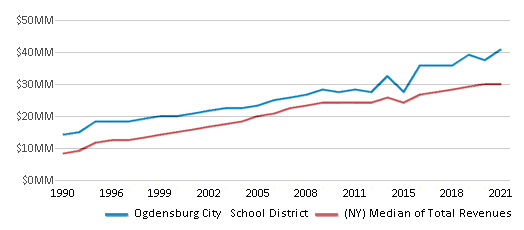
Spending
$42 MM
$80,737 MM

Revenue / Student
$34,483
$31,307
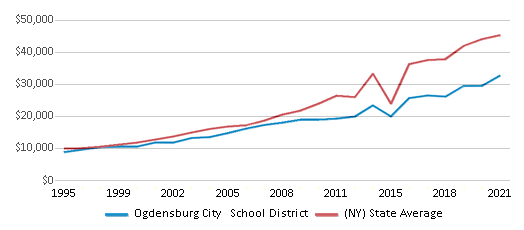
Spending / Student
$29,356
$32,183
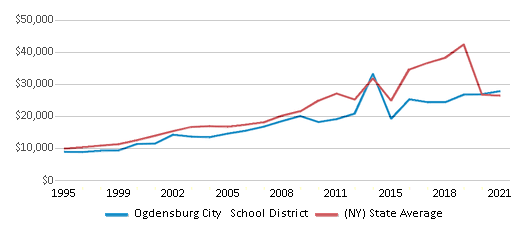
Best Ogdensburg City School District Public Elementary Schools (2025)
School
(Math and Reading Proficiency)
(Math and Reading Proficiency)
Location
Grades
Students
Rank: #11.
Madill School
(Math: 35-39% | Reading: 45-49%)
Rank:
Rank:
5/
Bottom 50%10
800 Jefferson Ave
Ogdensburg, NY 13669
(315) 393-7729
Ogdensburg, NY 13669
(315) 393-7729
Grades: PK-6
| 280 students
Rank: #22.
John F Kennedy School
(Math: 23% | Reading: 38%)
Rank:
Rank:
3/
Bottom 50%10
801-809 Park St
Ogdensburg, NY 13669
(315) 393-4264
Ogdensburg, NY 13669
(315) 393-4264
Grades: PK-6
| 462 students
Recent Articles

Year-Round Or Traditional Schedule?
Which is more appropriate for your child? A year-round attendance schedule or traditional schedule? We look at the pros and cons.

Why You Should Encourage Your Child to Join a Sports Team
Participating in team sports has a great many benefits for children, there is no doubt. In this article you will learn what those benefits are.

White Students are Now the Minority in U.S. Public Schools
Increasing birth rates among immigrant families from Asia and Central and South America, combined with lower birth rates among white families, means that for the first time in history, public school students in the United States are majority-minority. This shift in demographics poses difficulties for schools as they work to accommodate children of varying language abilities and socio-economic backgrounds.





